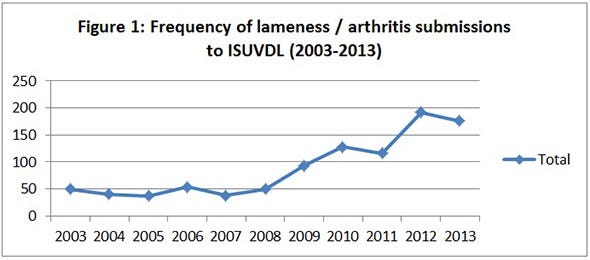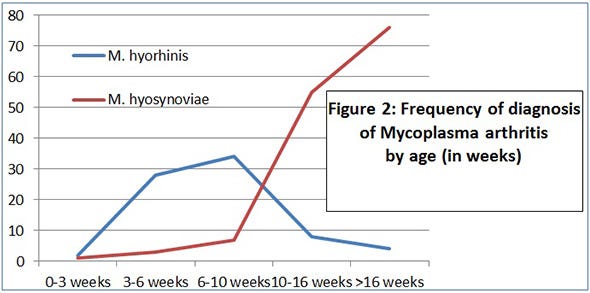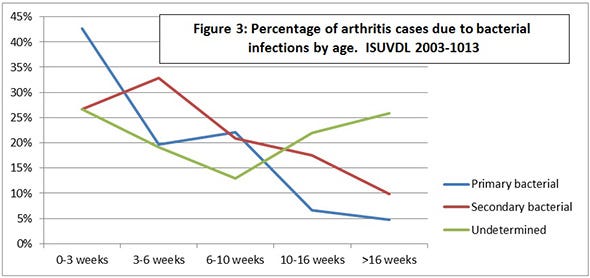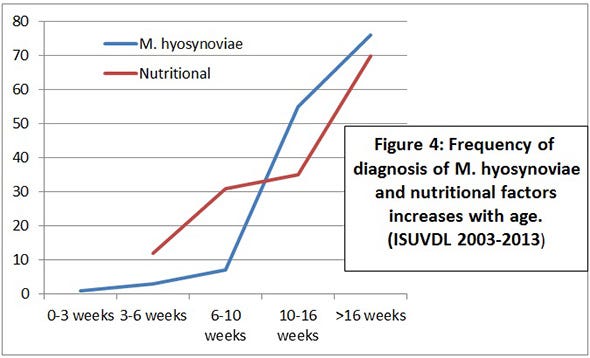July 28, 2014

Production losses due to lameness and joint disease are likely underestimated because losses often occur with such a low (but steady) rate to be taken for granted as “normal” or “acceptable”. Yet, these under-performing animals have delayed time to market, are a welfare issue and result in culls or mortality that can routinely approach 1% to 5% of total population.
It seems that only when the number of pigs that can’t walk or need to be culled reaches some ill-defined “tipping point” is some action taken. Figure 1 demonstrates an upward trend in the number of arthritis/lameness cases submitted to the Iowa State University Veterinary Diagnostic Laboratory (ISUVDL) . Lameness usually presents in one of two scenarios.
A “smoldering,” “endemic,” “low-grade,” “rolling,” “insidious” or “routine” occurrence of lameness/arthritis in individual pigs. The mechanism often is that pigs experience trauma and/or bacterial infection -- lameness -- cannot compete -- compromised growth and vigor -- additional trauma and bacterial infections -- culled or require euthanasia. Examination of these pigs is often unrewarding because of the chronic and cumulative nature of insults, risk factors or infectious agents that are continuously present in swine populations.
A group of animals suffer nearly simultaneous insult seen as an acute “epidemic” or “outbreak” of lameness. A large percentage of pigs develop a rather consistent clinical appearance of lameness. Depending on age and clinical presentation, there are a variety of “primary” insults which are capable of affecting many animals in a “non-routine” sort of way. Causes can be infectious (e.g. Mycoplasma spp., Erysipelothrix, Haemophilus among others) or noninfectious (e.g. nutritional, trauma, toxins).
What the Laboratory Finds
Mycoplasma and bacterial infections account for most of the arthritis diagnosed at ISUVDL. Viruses do not cause arthritis but can compromise health and predispose pigs to bacterial arthritis. Mycoplasma infections are often primary causes of arthritis, meaning they do not need obvious predisposing factors to cause disease. Mycoplasma hyorhinis tends to affect pigs 3 to 12 weeks of age whereas Mycoplasma hyosynoviae tends to affect pigs greater than 12 weeks, with increasing frequency as pigs get older (Figure 2).
Some bacterial infections can be primary (e.g. Haemophilus parasuis, Streptococcus suis, Actinobacillus suis, Erysipelothrix rhusiopathiae) and can cause acute joint infections. These and other agents (Trueperellla pyogenes, Streptococcus spp. Staphylococcus spp.) can also be secondary to other insults such as trauma, skin abrasions or other diseases (e.g. porcine reproductive and respiratory syndrome virus, swine influenza virus, porcine circovirus associated disease) that compromise health and vigor. Often the lesions of arthritis are chronic in the cases presented to the diagnostic laboratory, therefore a specific cause remains “undetermined” but most of these are a sequel to a previous bacterial infection (Figure 3).
Primary bacterial agents are more common in farrowing and nursery phase whereas secondary or “undetermined” bacterial causes tend to represent cumulative chronic insults that occur throughout the growing period. Of course, “primary” bacterial agents often have risk factors in management, particularly in early life where management changes can usually alleviate occurrence of joint infections.
Nutritional Contribution
Sorting out respective contributions of nutritional, traumatic and infectious contributors to arthritis and lameness can be difficult. The frequency of diagnosis of primary nutritional diseases such as rickets or acute hypocalcemia has increased in recent years, particularly from 2010-13. Osteochondrosis, while not definitively a nutritional disease, is included in the category of “nutritional” in represented in Figure 4. Mycoplasma hyosynoviae cases are displayed in the same figure to illustrate the similar age distribution and confusion that may emerge in getting an accurate diagnosis.
Diagnosis: Clinical Assessment and Diagnosis ‑ Look at the Pigs!
Assessing the animal in their environment is the single most important activity to define the root cause of the problem. The ability to spot affected animals early and to then “characterize or classify” the type and extent of lameness is critical to accurate diagnosis. It is important to note age, weight, history of movement or commingling, how many pigs are affected, how many and which legs are affected, and lesion location(s) on legs. Tissue swelling over the joint (a “callus” or “hygroma”) is often mistaken for a swollen joint. This swelling suggests that the animal may be lying down for longer periods, but it is not the cause of the lameness.
Be systematic and thorough in observations ‑ count and record number of animals, which legs, and lesion location to identify the predominant presentation. Finding one pig with a large abscess or an obvious broken leg usually does not accurately represent what is happening in the population.
Sampling Checklist for Submission for Laboratory Diagnosis
Are you sampling pigs that accurately represent the problem (not a junk pig)?
Are pigs sampled not medicated? Medication decreases ability to get a diagnosis.
Are sampled pigs in acute stages of disease?
Did you identify which limb or limbs are affected? Those are the ones to sample.
Do you have cleaned instruments and sample materials for collection?
Samples:
o Serum plus intact joints or joint fluids, joint swabs and synovium in formalin.
o Urine, feed and bone (second rib) should be collected routinely in the event nutritional contribution becomes a possibility.
You May Also Like



